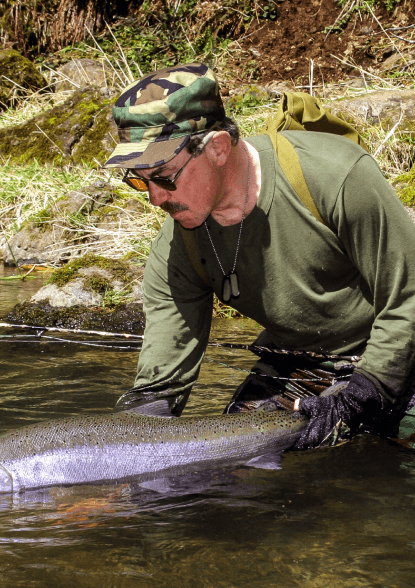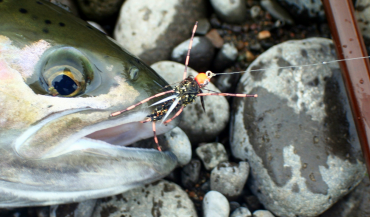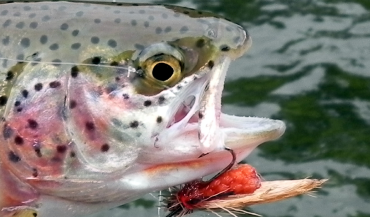A consistently effective steelhead fly angler must have an array of fly fishing techniques, able to fish the water column from the surface to the bottom. These would include skilled presentations of a dry fly, wet fly, and nymphs. It seems that most fly anglers I’ve observed, including steelhead fishing guides, are one dimensional, skilled in only one fly fishing method.
The most popularly employed fly fishing method for steelhead is the standard wet fly presentation. Here, the fly is cast across current, or slightly downstream. As the drift of the fly proceeds, mend the fly line to slow and sink the fly. Generally, the line is tight throughout the drift. The strike will be felt when the steelhead intercepts the artificial. Some readers may need to know or understand what mending the fly line means, let alone why effective mending is crucial to consistent success.
If you were to examine a cross-section of “typical” stream flow, you would observe that the highest water flow velocities are, essentially, at the surface. With depth, the water’s velocity slows due to friction of the uneven stream bottom. Near the bottom, especially where replete with boulders and scours, the current speed may be virtually zero. Therefore, what all this means for the fly angler is that as the fly sinks it slows down relative to the fly line and leader that are above the fly in faster water. If nothing is done after the cast of the fly the leader and line will, shortly, drag the fly down and across the current much faster than if the fly was thrown into the water and allowed to sink unattached, uninhibited by leader and line.
A mend is a manipulation of the fly line and leader whereby these are lifted and repositioned upstream of the relatively slower moving wet fly. To accomplish a successful mend lift the rod tip approximately 45 degrees above horizontal, then smartly move the tip upstream in a semi-circular arc. This is a slow, high, grandiose movement of the rod tip, which, ideally, repositions the entire fly line and most of the leader.
I will say it again: assuming your fly has landed in the current line through which you wish to drift your fly, a good mend would affect the line and most of the leader but not the fly. On a down-and-across cast, not affecting the line of drift of the fly is virtually impossible, so throw the fly beyond the current line you want to drift, knowing that when the mend is made it will pull the fly back towards you. An ineffective, but very common, mend is attempted with the rod tip much too close to horizontal. Repeat after me: “I’ll be mending high for a good drift of the fly.” Effective mends resulting in the slowing of the fly can be the difference between success and failure to entice a steelhead to strike the fly. A story is in order . . .
Those In-The-Know Make the Fly Go Slow
After more than forty years of fishing it, Jack Decius knew the North Umpqua and its steelhead well. One summer he invited me to join him for a couple of days on this fabled stream.
Being paralleled by high banks along much of its course, the North Umpqua lends itself to sight fishing for steelhead. From an elevated position, the observant angler using polarized glasses and binoculars can visually locate steelhead before casting to them. When the water flows remain at a constant level, migrating steelhead will often linger in very specific holding locations. As one fish moves upstream, another will move in to sit in the same preferred position. There is something peculiar and desirable to the fish about the hydraulics, light, depth, and/or sense of protection in these sweet spots.
At midsummer flows on the North Umpqua, Jack knew of one of these specific holding lies just barely upstream of the Wright Creek Bridge. Generous host that he was, Jack pointed out a resting steelhead exactly where he knew it would be. With a little study, viewing the area through polarized glasses, I, too, soon located the fish.
Jack formulated our game plan. He would stand on the bridge to watch the fish as I cast to it. So, I waded as deeply as I was able into the river from the right river bank. The steelhead was located left of center-stream, nestled in a cut in the stream’s bedrock bottom, and about 60 compass degrees down from straight across the current flow from me. The distance from me to the fish was approximately sixty feet. From my very low vantage point, having waded almost to my chest, I could not see the fish. Jack would be my eyes.
As I cast a #6 Green-Butt Skunk — probably the most popular pattern on the North Umpqua — Jack would orchestrate my actions. He dictated the angle of my cast, when to mend, and when to lengthen my line on successive casts.
On a long cast where the fly was thrown at a few degrees downstream of straight across the current, and mended mightily, Jack excitedly relayed that the steelhead had followed my swinging fly a short distance, then returned to its favored holding location. “Slow the fly” was his simple suggestion.
In my mind, I had a slight problem. Considering the monster mend I had performed on the previous cast, I did not know if I could slow the fly any more than I just had. The mend was as perfect as I could make it. However, if I angled the cast a little more upstream and mended an additional time maybe I could slow the fly just a little more.
The difference that seemed quite subtle to me made a major difference to the steelhead. As Jack watched and simultaneously commented on the fish’s behavior, I heard him say, “Here he comes!” As he finished the phrase, I felt the yank at the end of my line. Run, jump. Run some more, jump. Oh, no! The fish shortly won its freedom. That’s steelheading.
The lesson I learned that day was one of the invaluable nuances of enticing a steelhead on a wet fly: slow is good. I thought I had made the best presentation to the fish that I possibly could. I assumed that my presentation of the wet fly, including my mending of the line and leader, were as good as I was capable. But, because Jack was able to watch the fly presentation and the reaction of the fish, he prompted me to make another cast with specific encouragement to slow the drift of the fly. A fish I assumed was not interested in striking my fly was willing to do so IF I would only make a subtle change in the presentation. It made me wonder how many steelhead I could have hooked in past years if only I had slowed my wet fly just ever so slightly more.
There is a hackneyed phrase that says, “Even a blind pig — friend of the squirrel — finds a truffle now and then.” Even the unsophisticated, relatively-unskilled steelhead fly fisherman catches an aggressive steelhead on a swinging wet fly sometimes. Because they catch the occasional fish, they may assume that their presentation of the fly is adequate. If they do not hook a fish it is only because the steelhead is not interested, when, in fact, the fish would be interested if the presentation was refined a bit, including subtleties like slowing the fly with effective line mending. Another case of the Devil dwelling in the details. For more an expansive discussion of effective steelhead fly fishing, order a copy of my book Steelhead Fly Angling, Guerilla Fly Rod Tactics.



